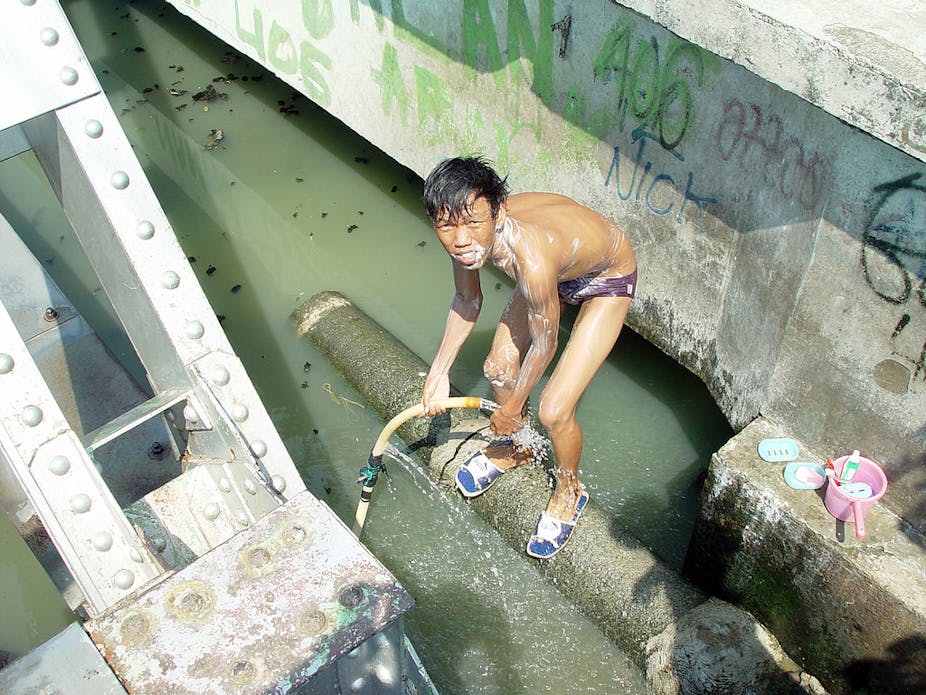Despite cuts to future aid spending since the Abbott government assumed office, the level of aid to Southeast Asia remains largely unchanged. What is in doubt is the space and the mechanisms for research and evidence to influence effective aid targeting.
How much aid is directed to ASEAN countries?
Poverty and inequality remain high priorities in several ASEAN countries. Australia’s engagement reflects this, with a large portion of the foreign aid budget allocated to six ASEAN countries with medium and low Human Development Indices.

Rising inequality poses a threat to poverty reduction in Asia. A recent Asian Development Bank report highlights this. The report argues, for instance, that poverty rates in Indonesia would be 10% lower than they are if not for rising inequality.
This raises questions about the right ways to target aid, since an over-simplified “economic growth” argument has already been demonstrated to be inadequate in Indonesia. This ASEAN country receives by far the largest portion of our foreign aid budget.
What directions underpin Australia’s engagement?
The government released its new aid policy in June this year. As noted in a popular development policy blog, the claimed “new” aid paradigm is closer to a continuation of the directions of the previous government.
The policy’s catch phrases, however, do indicate shifts in philosophy and thinking that sit uneasily with many working professionally in aid and development. The policy’s language of “promoting prosperity” and “enhancing stability” demonstrate the reorientation of the program to prioritise Australia’s interests and towards intentional support for economic and private sector development.
On the latter, it is not so much that development professionals and academics are opposed to the idea, but rather that related effective aid mechanisms to ensure benefits for the poor remain elusive. See, for example, the Independent Commission for Aid Impact (ICAI) assessment of the UK aid program private sector investments. This reports that these investments have mostly performed “relatively poorly overall against ICAI’s criteria for effectiveness and value for money”.
Private-sector-oriented approaches still require research and evidence to ensure they meet the aims of the aid program.
Other areas of aid programming also require ongoing research to question their assumptions and inform better decisions, beyond what standard project–level monitoring and evaluation can offer. While performance benchmarks can be set, much more is needed to navigate the complexities of targeting and delivering effective development aid investments.
Examples of aid-related research in ASEAN
Many organisations are actively engaged in research that aims to inform aid directed to ASEAN and elsewhere. We at the Institute for Sustainable Futures, University of Technology Sydney, are involved in a range of research initiatives aimed at improving aid effectiveness in ASEAN and other countries.
One DFAT grant we hold examines the role of small-scale enterprises in providing water and sanitation services for the poor in Indonesia, Vietnam and Timor-Leste. A systematic literature review quickly reveals the thin evidence base for assumptions that aid directed towards small-scale enterprise development necessarily benefits the poor.
The research points out the need for more nuanced approaches. These need to take in socio-economic and cultural contexts and be alert to the tendency for purely market-based approaches to fail the poor. The research also provides evidence of where significant impact can be achieved.
An example is through small-scale private water service providers in the Mekong in Vietnam. They achieve higher efficiency and lower costs than state-provided services. At the same time, these services provide livelihoods for their owners in rural areas.
Some 50 other such [DFAT research grants](http://aid.dfat.gov.au/research/Pages/adras-awards-2012.aspx are under way covering priority areas of the aid program. Examples in ASEAN countries include research to improve the evidence base on gender equality (Philippines, Mekong countries), health (Cambodia), education (Indonesia) and disability inclusive development (Indonesia, Cambodia, Laos and Philippines). All aim to underpin more effective aid and development. In addition, both thematic and country areas of the aid program directly contract program-related research.
A commitment to innovation, research and evidence?
This government’s commitment to such development-related research, beyond known allocations to agricultural and medical research, remains unclear.
On the one hand, the language of investment in innovation and a planned Innovation Hub with A$140 million allocated over four years “to identify, evaluate and help scale up innovations with high potential to generate significant development results” may provide a window to trial new approaches and develop increased evidence to underpin aid programming.
There are questions as to whether these funds will be mainly directed into various forms of leveraging private investment in development and in turn whether the pressure to produce “results” within one year of initiation will undermine potential for useful findings and outcomes to be generated. Even more critically, there are questions about the extent of the existing evidence base that can be drawn upon to justify use of these significant funds for such “innovation” when the poverty outcomes may be uncertain. This Innovation Hub will, it is hoped, provide space for engagement and debate on effective approaches to aid.
On the other hand, the aid policy makes no explicit mention of an intention to work with academia or universities as partners in the aid program. Instead, the status of the previous government’s research strategy (2012-2016) is in question. The administrative section to manage this strategy was disbanded with the merger of AusAID into the Department of Foreign Affairs and Trade in late 2013.
Hence mechanisms to procure and deliver quality research and evidence are left unclear. Further, the Office for Development Effectiveness (ODE), which is charged with assessing aid effectiveness across the aid program, has, like other parts of the department, had significant staff cuts.
It is time that the government provided greater information on its policy framework to guide research investment and assessment of effectiveness in the aid program. An upcoming ODE evaluation on research uptake will likely highlight some of the needs. In addition, the previous research strategy could, and indeed should, be adapted and built upon, to inform more effective, targeted aid in ASEAN countries and elsewhere.

